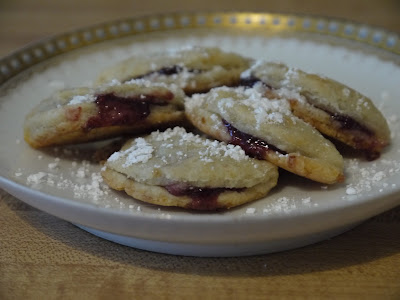Near the end of my Superb Pies and Pastries book, I came across this recipe for Pecan Pie that would help me do just that. Each pie only needs 1/2 of the plain pastry for the bottom crust!
Pecan Pie
(Makes one 8-inch pie)
1/4 cup butter
2/3 cup brown sugar, firmly packed
1/4 teaspoon salt
3/4 cup dark corn sirup
3 eggs, beaten
1 teaspoon vanilla
1/2 recipe Plain Pastry
1 cup pecan halves
1) Cream butter and sugar together until fluffy; add next four ingredients.
I used my KitchenAid mixer to cream the butter and sugar together, constantly scraping the bottom of the bowl to make sure everything at least touched the beater.
Then I added the salt, vanilla, eggs, and corn syrup, and let the mixer do its thing. By this point, the mixture was a sweet, beige, goopy mess. I've never cooked with corn syrup and I was absolutely certain I was using too much, but it looked and smelled like the stuff pecan pie is made of, so I pressed onward.
2) Line piepan with pastry and sprinkle with pecans.
I made the plain pastry just like I did the last time, and halved the dough to make two pie crusts. I have to say, the whole pastry-making process went a little smoother this time because I knew more about what to expect. Experience definitely helps. Still, I turned into a crazy dictator-person at times, and I want to take this moment to publicly apologize to my photography assistant. Taylor, I'm sorry you married an anxious, over-achieving perfectionist. I know now we aren't defusing bombs. We're just making pies. I'll try to remember that next time.
3) Pour the filling over pecans.
What I learned during this step is that it doesn't hurt to give the filling a few more stirs before pouring into the piepan. If you don't, you end up pouring a lot of corn syrup into the pie, and then slopping in the other ingredients that settled to the bottom of the mixing bowl.
Because I was making two pies, I had an instantaneous opportunity to improve my technique! When I made my second batch of pie filling, I was more careful to blend more thoroughly.
4) Bake in very hot oven (450 degrees F.) 10 minutes; reduce temperature to moderate (350 degrees F.) and bake 35 minutes longer or until knife inserted in center comes out clean.
See how the pie on the right is lighter than the pie on the left? I can't remember now which one had the thoroughly mixed pie filling, and which one had some gloppy layers of corn syrup and other "sediment" poured in, but that's why they look a little different. Strangely enough, they had no difference in texture or taste, and both baked beautifully. You'll also notice that the crust on the left looks a little crispier than the one on the right, and that it shrunk up a little more in the pan. I have a new pastry cloth with a really handy measuring guide to help me better approximate the appropriate crust size next time.
I have a few pecan pie-lovers and experts in my family, so I insisted that they taste it and provide feedback. All gave the pecan pie their glowing praise, but this may be more because I'm the baby of the family and less because it was truly prize-worthy. Still, I tasted the pies and I thought they were good, and I'm discovering my opinion of my cooking matters a lot, too.
I'm sorry there aren't any pictures of the inside. I forgot to take a picture of the pie after we cut it. Next time! So far, though, I'm 4/4 for my pie filling holding together. (I realize you just read in that last sentence a very awkward "four for four for," but I'm just going to let it go.)
So there you have it--two successful pecan pies to move the pie needle. What kind of pie should I make next?



















